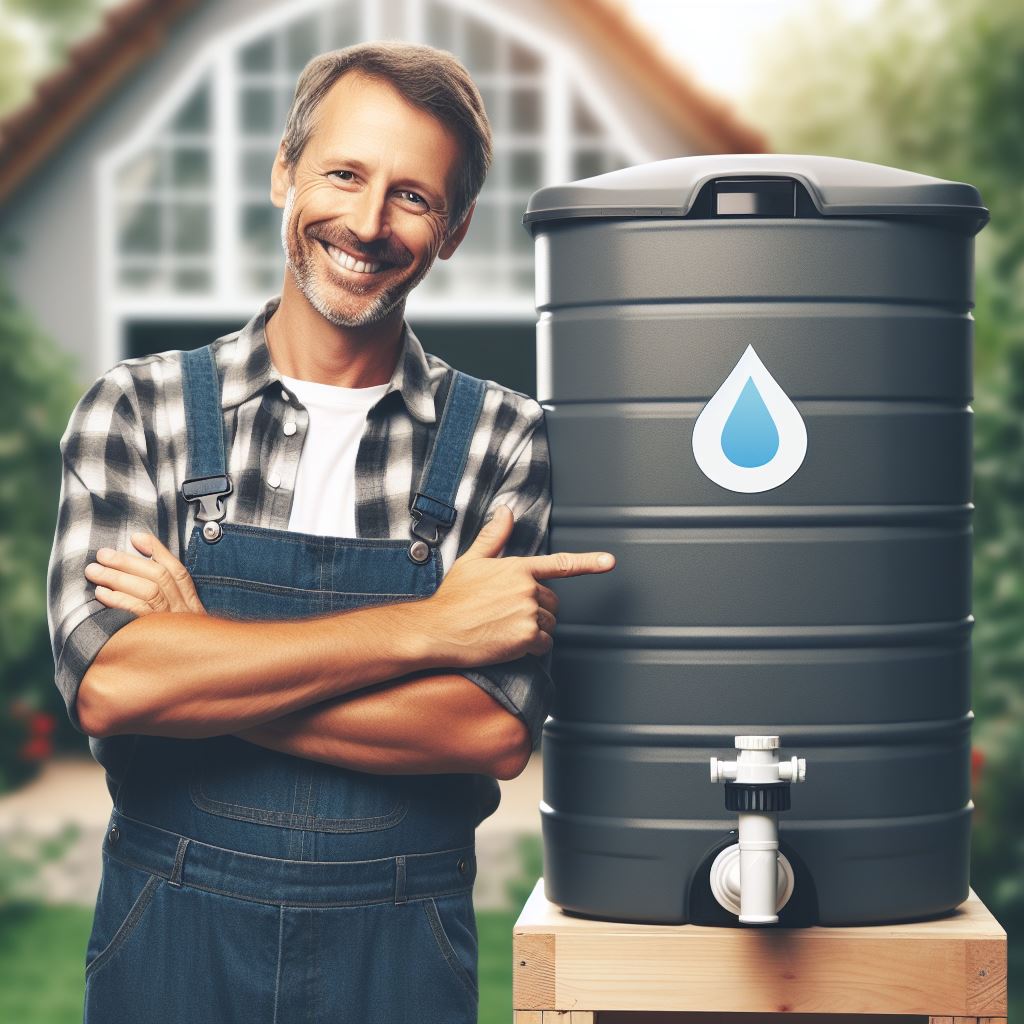Rainwater Harvesting Systems for Homes
Last Updated on January 26, 2024
Introduction
Rainwater harvesting systems for homes have gained popularity due to their environmental benefits and water conservation capabilities.
The purpose of rainwater harvesting systems is to collect and store rainwater that falls on roofs or other surfaces.
These systems reduce the reliance on municipal water supply and can be used for various household purposes such as irrigation and washing.
Rainwater harvesting systems have become increasingly important as water scarcity issues continue to rise globally.
Not only do these systems help conserve water, but they also reduce the strain on existing water resources.
In addition, rainwater harvesting systems promote self-sufficiency and sustainability in homes.
They are cost-effective and can significantly reduce water bills in the long run.
Furthermore, the collected rainwater is usually of high quality and free from chemicals, making it ideal for gardening and other non-potable uses.
The popularity of rainwater harvesting systems has grown among homeowners, as awareness of environmental concerns and water conservation increases.
Many governments and organizations also support the installation of rainwater harvesting systems through incentives and rebates.
Overall, rainwater harvesting systems for homes offer an effective and eco-friendly solution to address water scarcity issues while promoting sustainable living.
Read: Eco-Friendly Paints: A Guide for Homeowners
Benefits of Rainwater Harvesting Systems
Rainwater harvesting systems offer numerous benefits, including both environmental and economic advantages.
These systems play a crucial role in preserving natural water resources.
Environmental benefits
One of the significant environmental benefits of rainwater harvesting systems is their ability to preserve natural water resources.
By collecting rainwater, these systems offset the need for using freshwater sources, reducing the strain on available water supply infrastructure.
Furthermore, rainwater harvesting systems help mitigate stormwater runoff and erosion.
By capturing rainwater and directing it into storage tanks, they prevent excessive runoff, which can lead to erosion and contribute to water pollution.
Economic benefits
In addition to their environmental benefits, rainwater harvesting systems offer economic advantages.
Many homeowners experience a reduction in their water bills by utilizing rainwater for various purposes such as irrigation, toilet flushing, and laundry.
Governments often provide incentives and rebates to encourage the adoption of rainwater harvesting systems.
These incentives can include financial assistance or tax benefits, allowing homeowners to offset a portion of the system’s installation and maintenance expenses.
Moreover, rainwater harvesting systems result in long-term cost savings.
Once installed, they provide a reliable alternative water source that is free and readily available.
This reduces homeowners’ reliance on municipal water supply, which is subject to price fluctuations and potential scarcity.
Personal benefits
The personal benefits of rainwater harvesting systems should not be overlooked either.
By collecting rainwater, homeowners gain access to a clean and chemical-free water source.
This can be particularly advantageous for gardening, as plants tend to thrive when irrigated with rainwater instead of chlorinated tap water.
Rainwater harvesting systems also promote self-sufficiency and resilience.
During periods of water scarcity, such as droughts or utility disruptions, homeowners with rainwater storage can continue to meet their water needs independently.
This enhances their ability to manage and adapt to environmental challenges.
In fact, rainwater harvesting systems offer a wide range of benefits.
Their environmental advantages include the preservation of natural water resources, reduction of strain on water supply infrastructure, and mitigation of stormwater runoff and erosion.
Economically, homeowners can expect lower water bills, potential government incentives, and long-term cost savings.
On a personal level, rainwater harvesting systems provide access to clean water and increase self-sufficiency and resilience.
Embracing these systems can contribute to a more sustainable and resource-efficient future for both individuals and communities.
Read: Eco Lighting Solutions for Your Home

Components of a Rainwater Harvesting System
Rainwater harvesting systems for homes consist of various components that work together to collect, store, and distribute rainwater efficiently.
Roof collection system
The first component is the roof collection system. It involves using appropriate roofing materials that can effectively collect rainwater.
These materials should be durable and have a smooth surface to allow water to flow easily.
Additionally, gutters and downspouts are installed to direct rainwater into a storage tank or cistern.
To prevent debris from entering the system, leaf guards and filters are essential.
They help in filtering out leaves, twigs, and other particles that could contaminate the collected rainwater.
Storage tanks or cisterns
The second component is the storage tanks or cisterns.
There are different types and materials available, such as plastic, concrete, or metal tanks.
When selecting the tank size and capacity, factors like the average rainfall in the area and the household’s water needs should be considered.
It’s also important to regularly maintain and clean the tanks to ensure the stored water remains clean and safe for use.
Conveyance system
The third component is the conveyance system, which includes pipes and fittings that transport rainwater from the collection point, such as the gutter downspouts, to the storage tank.
Proper sizing and installation of these pipes and fittings are crucial for optimal flow and to avoid any leakage or blockages.
Pumping and distribution system
The last component is the pumping and distribution system.
It involves using pumping mechanisms to supply rainwater for various household uses, such as irrigation, toilet flushing, and laundry.
Additionally, water treatment options should be considered to make the collected rainwater potable, especially for drinking and cooking purposes.
In times of low rainfall, backup systems, such as connecting the rainwater harvesting system to the main water supply, should be in place to ensure a continuous water supply.
In short, a rainwater harvesting system for homes comprises a roof collection system, storage tanks or cisterns, a conveyance system, and a pumping and distribution system.
Each component plays a crucial role in ensuring efficient water collection, storage, and distribution for everyday household needs.
Proper selection, installation, and maintenance of these components are vital for the optimal functioning of the rainwater harvesting system.
Read: Low-Impact Landscaping for Greener Homes
Installing a Rainwater Harvesting System
A rainwater harvesting system is a great addition to any home, providing a sustainable and cost-effective solution for water supply.
However, installing such a system requires careful planning and consideration.
In this post, we will explore the feasibility assessment, the option of hiring professionals or taking the DIY approach, and the necessary maintenance and monitoring.
Feasibility assessment for homes
- Climate and rainfall patterns play a crucial role in determining the effectiveness of a rainwater harvesting system.
- Calculating the roof area and estimating the water demand of your home helps determine system capacity.
- Checking local regulations and obtaining permits are essential to ensure compliance and legal operation.
Hiring professionals or DIY approach
- Consulting with experts in rainwater harvesting helps understand the intricacies and potential challenges of installation.
- Obtaining the necessary tools and materials is crucial for a successful DIY approach.
- Installing and setting up the system involves a series of steps that should be followed accurately.
Maintenance and monitoring
- Regular inspection of system components, such as filters, pumps, and gutters, is necessary to identify and rectify any issues.
- Following cleaning and repair guidelines ensures optimal system performance and longevity.
- Monitoring water quality periodically and assessing system performance helps maintain an efficient harvesting system.
Installing a rainwater harvesting system requires careful consideration, feasibility assessment, and adherence to local regulations.
Consulting experts for guidance, or opting for a DIY installation if you have the necessary knowledge and tools, can help in achieving a successful system setup.
Additionally, regular maintenance and monitoring are crucial to ensure the system functions properly and provides clean, high-quality water for various household purposes.
Read: Water-Saving Fixtures for Eco Bathrooms
Conclusion
Rainwater harvesting systems offer numerous benefits such as reducing water bills, minimizing demand on municipal water supplies, promoting sustainable living, and providing a backup water source.
These systems consist of catchment areas, gutters, downspouts, storage tanks, filters, and distribution systems.
Considering the advantages and ease of implementation, it is highly recommended for readers to install rainwater harvesting systems in their homes.
By doing so, they not only contribute to water conservation efforts but also enjoy the advantages in terms of cost savings and environmental impact.
For those interested in learning more about rainwater harvesting systems, several resources are available.
Websites such as the Rainwater Harvesting Implementation Network (RAIN) provide detailed information on the topic.
Additionally, local government agencies or water conservation organizations may offer guidance and assistance for implementing these systems.
Overall, rainwater harvesting systems are a sustainable solution for water conservation in homes.
By summarizing the benefits, encouraging implementation, and providing additional resources, individuals can easily take a step towards a more eco-friendly lifestyle while reaping multiple benefits for themselves and the environment.


